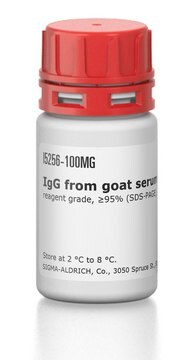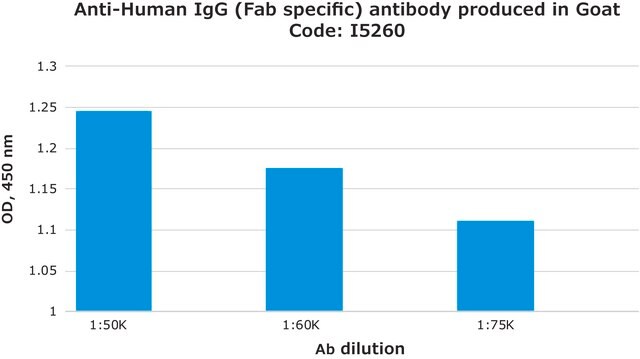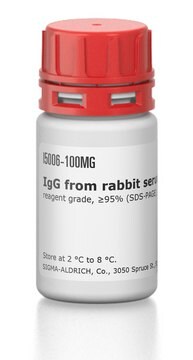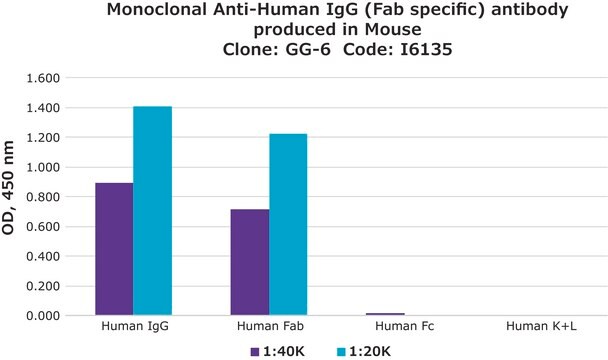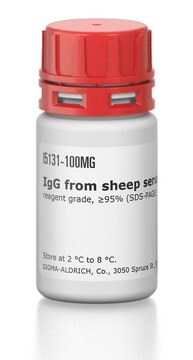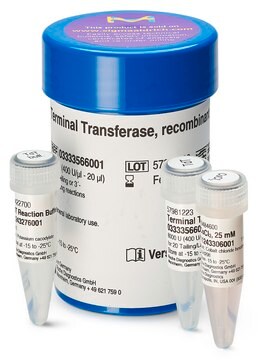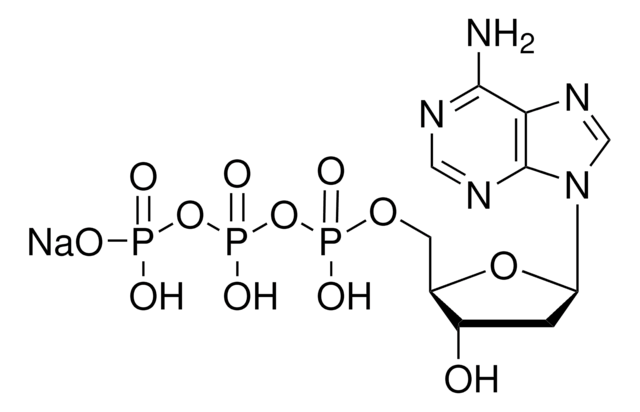I9140
IgG from goat serum
technical grade, ≥80% (SDS-PAGE), buffered aqueous solution
Synonym(s):
Goat IgG
Sign Into View Organizational & Contract Pricing
All Photos(1)
About This Item
Recommended Products
conjugate
unconjugated
Quality Level
grade
technical grade
Assay
≥80% (SDS-PAGE)
form
buffered aqueous solution
technique(s)
ChIP: suitable
immunohistochemistry: suitable
shipped in
dry ice
storage temp.
−20°C
Looking for similar products? Visit Product Comparison Guide
General description
Goat IgG is a glycoprotein antibody that is fractionated from pooled normal goat serum. In immunoelectrophoresis, goat IgG yields a single major arc of precipitation in the γ region against anti-goat IgG and anti-goat whole serum. Minor γ arcs may also be observed against anti-goat whole serum.
IgG antibody subtype is the most abundant serum immunoglobulins of the immune system. It is secreted by B cells and is found in blood and extracellular fluids and provides protection from infections caused by bacteria, fungi and viruses. Maternal IgG is transferred to fetus through the placenta that is vital for immune defence of the neonate against infections
Goat IgG is purified from normal goat serum by fractionation.
Goat IgG is purified from normal goat serum by fractionation.
Application
In immunohistochemical applications, IgG from goat serum can be used as a blocking agent (500 μg/ml in paraformaldehyde-fixed mouse uterus sections) or as a negative control (1:56000 in pig cecal tissue).
Technical grade IgG may be used as an economical alternative to the reagent grade immunoglobulins, in applications where high purity is not required. Goat IgG was used as negative control antibody in immunohistochemical staining of cecal tissue of pigs at a dilution of 1:56000. Goat IgG was used in immunohistochemistry of rat brain sections at a concentration of 2 μg/ml. The antibody was also used in chromatin immunoprecipitation and as control in infection inhibition assay.
Physical form
Solution in 0.01 M phosphate buffered saline, pH 7.2 containing 15 mM sodium azide
Disclaimer
Unless otherwise stated in our catalog or other company documentation accompanying the product(s), our products are intended for research use only and are not to be used for any other purpose, which includes but is not limited to, unauthorized commercial uses, in vitro diagnostic uses, ex vivo or in vivo therapeutic uses or any type of consumption or application to humans or animals.
Storage Class Code
10 - Combustible liquids
WGK
WGK 3
Flash Point(F)
Not applicable
Flash Point(C)
Not applicable
Personal Protective Equipment
dust mask type N95 (US), Eyeshields, Gloves
Choose from one of the most recent versions:
Already Own This Product?
Find documentation for the products that you have recently purchased in the Document Library.
Customers Also Viewed
Jan Gunnar Sørbø et al.
FEBS letters, 581(25), 4884-4890 (2007-09-28)
Aquaporin-4 (AQP4) has been reported to be upregulated post-partum in pregnancy and in early lung development. Several technical challenges exist in measuring AQP4 protein levels, among them sensitivity to detergent solubilization, sample heating and gel composition. Here we have optimized
Malene M Nørgaard et al.
The Southeast Asian journal of tropical medicine and public health, 36(6), 1394-1398 (2006-04-14)
The pig has been proposed as a model for human schistosomiasis japonica and the use of this animal model is increasing. The inflammatory response to schistosome infection in the liver and intestine of the pig shows morphological differences, and only
Michael Curley et al.
Scientific reports, 9(1), 15037-15037 (2019-10-23)
Exogenous androgen replacement is used to treat symptoms associated with low testosterone in males. However, adverse cardiovascular risk and negative fertility impacts impel development of alternative approaches to restore/maintain Leydig cell (LC) androgen production. Stem Leydig cell (SLC) transplantation shows
R Froehlich et al.
Placenta, 33(3), 195-201 (2012-01-14)
The concept of a network within the family of adhesion/growth regulatory galectins implies distinct spatio-temporal expression profiles. To test this assumption immunohistochemically for bovine placenta, placentomal (P) and interplacentomal tissues (IP) were collected at a slaughterhouse from the three stages
Michio Kitajima et al.
Archives of histology and cytology, 67(5), 465-474 (2005-03-23)
The arylhydrocarbon receptor (AhR) is a nuclear transcription factor mediating toxic effects of chemicals such as dioxins. The 2,3,7,8-tetrachlorodibenzo-p-dioxin (TCDD), a member of polyhalogenated aromatic hydrocarbons family, exerts a wide-variety of toxic effects in a tissue- and species-specific manner including
Our team of scientists has experience in all areas of research including Life Science, Material Science, Chemical Synthesis, Chromatography, Analytical and many others.
Contact Technical Service